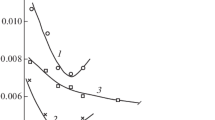Summary
Oil/water contact angles, coefficient of friction and electron diffraction have been used to study the adsorption of three long chain surface-active substances (a fatty acid, a sulphate and a substituted amine, from aqueous solution on to electropolished copper, aluminium and iron. According to the pH of the solution, the adsorption occurs by one of the following processes (a) physical adsorption, (b) chemisorption, (c) adherence of a precipitate, (d) sensitised adsorption to form a mixed film. Certain applications e.g. lubrication and the prevention of fretting corrosion, are discussed in relation to the structure and rate of adsorption of the four types of film. The first requirement for an efficient lubricant film is the chemisorption of the long chain compound as a basic metal soap. The film is considerably strengthened by subsequent adsorption of a less polar compound, such as cholesterol, by process (d). A suitable vehicle for the two compounds is an oil/water emulsion.
Electron diffraction has been used to determine the physical and chemical nature of the electropolished metal surfaces. Adsorbed monolayers can only be detected on extremely smooth surfaces. A new technique is described for depositing insoluble monolayers on reactive metals, which avoids the roughening of the metal surface experienced in the normal Langmuir-Blodgett method.
Zusammenfassung
Randwinkel öl-Wasser, Reibungskoeffizient und Elektronenstrahlbeugung wurden benutzt zum Studium der Adsorption dreier langkettiger Substanzen (eine Fettsäure, ein Sulfat und ein substituiertes Amin) aus wäßriger Lösung heraus auf elektropoliertes Kupfer, Aluminium und Eisen. Entsprechend dem pH-Wert der Lösung geschieht die Adsorption durch einen der folgenden Prozesse:
a) Physikalische Adsorption, b) Chemisorption, c) Haftung eines Niederschlags und d) sensibilisierte Adsorption unter Bildung eines Mischfilms.
Einige Anwendungen, z. B. Schmierung und die Verhinderung von Reibungskorrosion, wurden unter BerÜcksichtigung der Struktur und der Adsorptionsgeschwindigkeit der vier genannten Typen von Adsorptionsschichten diskutiert. Die erste Bedingung fÜr wirksame Schmierung ist die Chemisorption der langkettigen Substanz als basische, metallorganische VerdÜnnung (Seife). Der erhaltene Adsorptionsfilm erfährt eine beachtliche Verfestigung durch nachfolgende Adsorption (nach dem Prozeß d) einer schwächer polaren Substanz, wie des Cholesterols. Ein brauchbarer Träger fÜr beide Komponenten ist eine öl-Wasser-Emulsion.
Zur Aufklärung der chemischen und physikalischen Eigenschaften der elektropolierten Metalloberflächen wurde die Elektronenstrahlbeugung eingesetzt. Adsorbierte Monoschichten können nur auf extrem ebenen Oberflächen beobachtet werden. Zur Verhinderung der Aufrauhung von Metalloberflächen, wie sie von der Langmuir-Blodgett-Methode her bekannt ist, wurde eine neue Auftragungstechnik fÜr unlösliche Monoschichten auf reaktionsfähige Metalloberflächen entwickelt.
Similar content being viewed by others
References
Wolstenholme, G. A. and J. H. Schulman, Trans. Farad. Soc.46, 475 (1950);47, 788 (1951).
Schulman, J. H. and M. Z. Dogan, Trans. Farad. Soc.50, 158 (1954).
Thomas, J. G. N. and J. H. Schulman, Trans. Farad. Soc.50, 1131 (1954).
Schulman, J. H. and J. Leja, Kolloid-Z.136, 107 (1954).
Bowden, F. P. and D. Tabor, Friction and Lubrication of Solids, 74 (London 1950).
Eldredge, K. R., Ph. D. Thesis (Cambridge University 1953).
Cuming, B. D., Ph. D. Thesis (Cambridge University 1954).
Spink, J. A. and J. V. Sanders, Trans Farad. Soc.51, 1154 (1955).
Hirst, W. and J. K. Lancaster, Proc. Roy. Soc. A223, 324 (1954).
Blodgett, K. B., J. Amer. Chem. Soc.57, 1007 (1935).
Bikerman, J. J., Proc. Roy. Soc. A170, 130 (1939).
Spink, J. A., M. Sc. Thesis (Melbourne University 1954).
Allen, J. A., Trans. Farad. Soc.48, 273 (1952).
Shafrin, E. G. and W. A. Zisman, Monomolecular Layers (New York 1954).
Sameshima, J., Rev. Phys. Chem.14, 55 (1940).
Bowden, F. P. and D. Tabor, Friction and Lubrication of Solids, 202 (London 1950).
McBain, J. W., Colloid Science, 189 (London 1950).
Mokrushin, S. G., Trans. Farad. Soc.43, 1 (1947).
Goddhard, E. D. and J. H. Schulman, J. Colloid Sci.8, 309 (1953).
Author information
Authors and Affiliations
Additional information
This work was carried out during the tenure of Consolidated Zinc Studentships at Trinity Hall, Cambridge, on the part of two of the authors (R. B. W. & J. A. S.). Further financial support was provided by Almin Limited and C. S. I. R. O. (Australia).
Rights and permissions
About this article
Cite this article
Schulman, J.H., Waterhouse, B.B. & Spink, J.A. Adhesion of amphipathic molecules to solid surfaces. Kolloid-Zeitschrift 146, 77–95 (1956). https://doi.org/10.1007/BF01502238
Received:
Issue Date:
DOI: https://doi.org/10.1007/BF01502238



